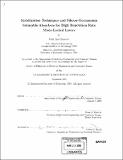Stabilization techniques and silicon-germanium saturable absorbers for high repetition rate mode-locked lasers
Author(s)
Grawert, Felix Jan
DownloadFull printable version (14.08Mb)
Other Contributors
Massachusetts Institute of Technology. Dept. of Electrical Engineering and Computer Science.
Advisor
Frans X. Kärtner.
Terms of use
Metadata
Show full item recordAbstract
The monolithic integration of passively mode-locked solid-state lasers at highest repetition rates has been prevented by Q-switching instabilities and the lack of integrable saturable absorbers to date. In this thesis we demonstrate in theory and experiment that active feedback electronics controlling the intracavity loss of the laser is capable of suppressing the Q-switching instability. We introduce a control system's perspective to the stability of saturable absorber mode-locked lasers. This approach unifies the existing methods of laser stabilization and identifies feedback control with an intracavity loss modulator as a universal stabilization scheme, applicable without restrictions to lasers at the highest repetition rates. This finding is validated in laboratory experiments by showing that a laser which is unstable without feedback control can reach a noise performance equivalent to that of a, passively stabilized laser, once the feedback controller is engaged. The addition of feedback stabilization does not negatively affect the pulse shaping dynamics, since controller and mode-locking dynamics occur on vastly different timescales. Furthermore, we address the materials challenge of manufacturing a CMOS-compatible saturable Bragg reflector in the Si-SiO2-Ge materials system, enabling the monolithic integration of the absorber with the laser gain medium of future compact mode-locked lasers. A wafer-scale Si-SiO2 high reflector with 99.8% peak reflectance and an unprecedented bandwidth of 700 nm in the near-infrared serves as the substrate of a saturable Bragg reflector, while a germanium layer grown on top provides saturable loss. (cont.) Ultrafast recovery of the saturation is observed in pump-probe measurements, indicating the operation of the saturable Bragg reflector as a fast semiconductor saturable absorber in the laser. In contrast, strong inverse saturable loss occurs in the regime of high fluence, contributing to stabilization against Q-switching instabilities. An erbium-ytterbium:glass laser mode-locked with the silicon-germanium saturable Bragg reflector generates the shortest pulse and broadest optical spectrum obtained from a bulk Er-Yb:glass laser to date. Spanning the C-band of optical communications on a ±10 dB level, it demonstrates that mode-locked Er-Yb:glass lasers can serve as multi-wavelength laser sources in next-generation optical communications systems, providing all channels across the communications spectrum with a stable train of pulses.
Description
Thesis (Ph. D.)--Massachusetts Institute of Technology, Dept. of Electrical Engineering and Computer Science, 2005. Includes bibliographical references (p. 163-176).
Date issued
2005Department
Massachusetts Institute of Technology. Department of Electrical Engineering and Computer SciencePublisher
Massachusetts Institute of Technology
Keywords
Electrical Engineering and Computer Science.